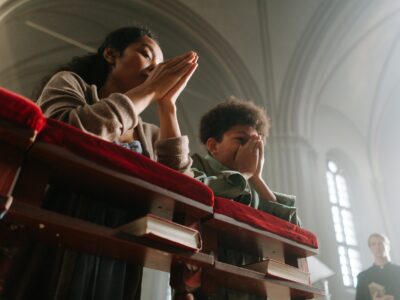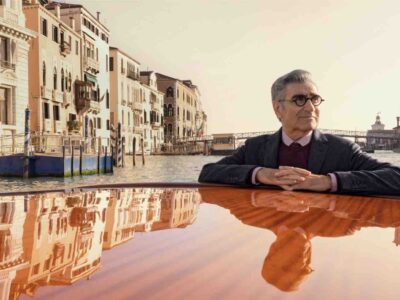Every other year, thousands of writers and literature enthusiasts descend on Calvin University’s campus in Grand Rapids, Michigan, for four days of conversations between mostly introverts, all trying their best to socialize between sessions and presentations at the Festival of Faith and Writing.
It is one of my favorite literary events, and this was the first year since 2018 that the Festival was held in-person, so of course I went, eager to connect with so many writer friends and soon-to-be friends.
While I was there, I caught up with four presenters and writers of faith whose work gravitates around nature, the environment, and creation care to ask why they feel called to use their gift of writing to talk about the environment?
Here’s what they had to say.
Beth Peterson and the Hope of Storytelling
Image Courtesy of author Beth Peterson
“My interest in writing about creation care really began when I was living in Norway on the edge of this quickly disappearing landscape,” said Peterson.
“Before I moved to Norway I didn’t know anything about the glacier,” she said, but then, “I watched it recede from being ice to being a literal lake in 10 years. I used to be able to see it from my window. Then I had to take a bus to see it.”
Peterson’s first-hand exposure to a warming world compelled her storytelling.
“I realized that the climate science and information tactics to try to influence more environmental stewardship wasn’t really working,” Peterson said. “I started to write and to read. Perhaps narrative is the way to help people get invested in these places. Perhaps if they see themselves in the page, they’ll see the beauty and vitality of these gorgeous, quickly fading landscapes.”
“Theologically, it’s part of my belief that God invites humans to be part of the restoration of all things. I feel as though environmentalism and environmental art can be important for that,” said Peterson.
Some research on brain science indicates that our minds interpret art differently than sheer facts or information. “Our interpretation of art is closer to our decision making centers in our brains,” said Peterson, and engaging with art “can lead to more emotional change.”
“We’re all in the midst of information overload – our creative writing can be ways to process what’s happening in the world in terms of the environment.”
Christians have a unique theological foundation that offers hope in the midst of climate despair. It goes beyond just fixing the individual issue or fixing the systemic structure, to the promise that “things will eventually be restored. And it’s our pleasure to work towards that,” said Peterson.
“It feels like the environment is falling apart. Individual heart change matters and societal change matters of course, but also there’s a creator God who made all things and plans to restore them,” said Peterson.
“Christian environmentalists don’t give in to despair.”
Fred Bahnson, Soul Nourishment, and His Agrarian Conversion
Fred Bahnson delivers a lecture. Image courtesy of The Chautauqua Daily.
“My journey as a writer and my work as an environmental thinker have proceeded in tandem. For me that awakening happened in Mexico,” Bahnson shared. Bahnson wrote about much of his spiritual and environmental journey in his book, Soil and Sacrament. You can read my review of the book here.
Bahnson calls his environmental and spiritual awakening “an agrarian conversion” in Mexico. “Growing food helps train us and teaches us our dependence on the natural world – it is the thing that feeds us. That was the initial awakening,” said Bahnson.
“As I’ve read a lot of the early church writers and church fathers and mothers, I’ve come to a sacramental understanding of food. One of the ways God nourishes us is food. It isn’t fuel for the machine, it’s nourishment, it’s love – and we get that through creation.”
Marilyn McEntyre and Riparian Places
Author Marilyn McEntrye – Image Courtesy of Eerd
For Marilyn McEntyre, the call to greater ecological awareness and engagement was rooted in what she called “epiphanic moments” linked to particular words or phrases. Language and vocabulary carry a lot of power, and for McEntyre, phrases like “look upstream,” “predatory lending,” and “factory farm” raised her conscience.
“Once you learn a term you think about justice differently,” McEntyre said.
McEntyre was born into a missionary family but grew up during the Vietnam War and didn’t attend a Christian college. Faced with a broader worldview, her perspective also broadened.
“Going from the ‘me and Jesus’ vertical axis to a community – or koinonia – understanding of our participation in the world” gave McEntyre the sense that “we are a part of something that’s happening,” something more than just that vertical “me and Jesus” axis.
That “something more” spans present-day communities, stretches back in history, and even transcends time and space. The liturgical framework of the church has provided scaffolding for this larger sense of connectivity.
“I get to be part of this huge story, something happening that’s not all about me,” she said.
Within that large story, McEntyre has found herself hanging out at the boundaries of disciplines, looking for bridges. “I love these places of intersection—riparian places,” where life is the most diverse, she said. These points of intersection have flavored her work. From new physics to metaphysics to shifting political systems, there’s really nothing off limits.
And in all those places there’s great joy and freedom.
“My deepest hope is that we are being held in divine love,” said McEntyre. “We’re sent here on this journey for purposes we’ll find out later, and in the meantime we have to trust that we have to do what we are called to do, which keeps unfolding.”
“You never know what you are being prepared for,” said McEntyre. “I must be being prepared for whatever’s next. I find myself a lot less troubled resting in that space.”
Gayle Boss and the Seasons of Creation
Author Gayle Boss poses with a stuffed fox. Image Courtesy of UC Events.
Gayle Boss is the author of All Creation Waits and Wild Hope, devotionals I’ve reviewed and celebrated here.
“All Creation Waits started as an advent calendar for my children. My older son was four and I was pregnant with my second son,” said Boss. “I was raised in the north woods and liked to be outdoors. But environmental action wasn’t my urgency – I was enrapt by spiritual practices, learning more about contemplatives and ritual. I found these practices so helpful for me and began trying to introduce these things into our family.”
Before Boss first began her advent calendar project, one of her friends told her how a turtle knows how to wait—not because it’s forced or is grieving, but for health. “I began with the turtle on day one. I learned how the animal world follows the patterns and seasons of rhythms,” said Boss. It turned out that Boss wasn’t the only one who wanted people to engage with the contemplative practice of advent. “The whole creation waits. The animals can lead us; they know.”
“The ecological crisis is now in the collective conscience as well as mine,” said Boss, and the work that began as an animal-driven advent calendar for two children has evolved into a deep, rich, illustrated exploration of the liturgical seasons, the aches and groans of creation, and the responsibility we have to know, love, and care for the creatures around us.
When we know about something, we are compelled to love it, and when we love something, we are compelled to take care of it. This is the work all four of these writers are driven to do, to expand our knowledge, enlarge our hearts, and compel us to take action through their stories.





 Copyright
2024
Root and Vine
Copyright
2024
Root and Vine